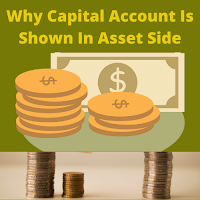Why Capital Account Is Shown In Asset Side
Is It Possible To Show Capital On Asset Side Of A Balance Sheet?
Usually, the Capital Account Is Shown On Liabilities & Equity Side of a balance sheet. However, there are possibilities due to which Capital Account is appeared on asset side of balance sheet. In that case, the capital account is called a negative capital account and it is not a good sign for the Stability of A Business as it has less capital to invest, to meet daily obligations and ultimately the business will surely face a heavy loss or even may be closed at the end.
Such possibilities are shown below:
(i) Due To Net Loss
As the business suffered a Loss during the accounting period, so we get negative capital. In such case, the owners of the business must do serious steps to stabilize their businesses.
For example, Mr. A is a sole proprietor has negative capital during the period. From his financial statements, we get the following information:
Closing Capital = Opening Capital - Net Loss - Drawings
= 50000 - 70000 - 10000
Closing Capital = Rs. -30000
(ii) Overdrawings
There is also a possibility of overdrawings i.e., a sole owner withdrew more than the capital, then also, in this case, the capital is negative and shown on asset side of a business’s
balance sheet. In that case, the owner is liable to pay to the business for the excess of withdrawings.
For example, if Mr. A started business with cash Rs. 30000. He withdrew Rs. 80000 from his business for his personal use. His business net profit for the year is Rs. 40000, then ending capital is calculated as shown below:
Ending Capital = 30000 + 40000 - 80000 = Rs. -10000
The ending capital (Rs. -10000) is negative which is appeared on asset side of Mr. A’s balance sheet.

Comments